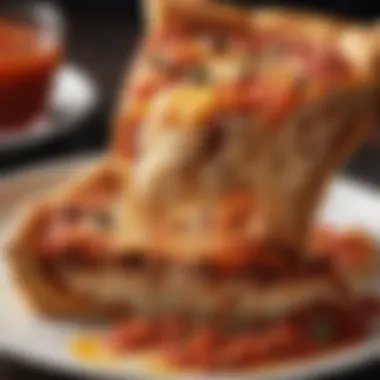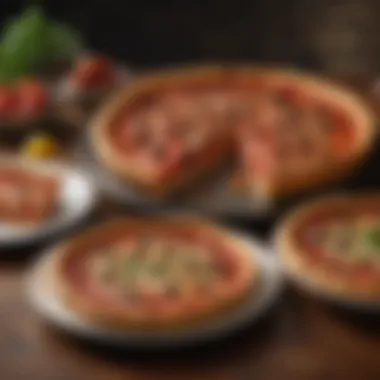Exploring Deep Dish Chicago: A Culinary Landmark


Intro
Deep dish pizza represents more than just a meal in Chicago; it is an embodiment of a city's culinary evolution. As we delve into the layers of this iconic dish, we aim to unpack its storied origins, structural characteristics, and the cultural significance that permeates the urban landscape.
This article is a comprehensive guide for pizza lovers and culinary enthusiasts alike. From its preparation to regional variations, we will explore what makes deep dish pizza a culinary landmark. By the end, readers will possess not only a deeper understanding of deep dish pizza but also be equipped with practical insights on its preparation, popular ingredients, and serving suggestions.
We will also touch on how deep dish pizza fits into the broader pizza ecosystem, showcasing its unique traits while acknowledging its counterparts. It is this blend of tradition and modern interpretation that keeps deep dish pizza relevant in today’s gastronomic conversations.
Foreword to Deep Dish Pizza
Deep dish pizza holds an esteemed place in the culinary landscape of Chicago. This unique type of pizza is more than just a meal; it reflects a rich cultural heritage and has evolved over decades. The following sections will examine why deep dish is not merely food but a symbol of Chicago's vibrant identity.
Deep dish pizza invites people to explore its deeper aspects, including its structural design, ingredient choices, and cultural significance. Every bite is a history lesson, making it essential for pizza lovers, cooking enthusiasts, and foodies alike to understand its intricacies. This exploration reveals how deep dish pizza became a beloved staple and a culinary landmark.
Understanding the Concept of Deep Dish
Deep dish pizza is characterized by its thick, high edges. This design creates a sturdy crust that can hold a generous amount of toppings. This contrasts sharply with other pizza styles, which often feature a thin crust. The pizza ingredients are layered in a specific order—cheese first, followed by toppings, and finally, a lavish red sauce on top. This construction not only preserves the flavors of each ingredient but also helps maintain the structural integrity of the pizza. The unique build of deep dish is part of what makes it memorable.
The idea of a deep dish dates back to the early 20th century in Chicago. Pioneers like Ike Sewell and Ric Riccardo were instrumental in popularizing this style. Their establishments laid the groundwork for what would become an enduring culinary tradition in the city.
Cultural Relevance of Deep Dish in Chicago
Examining the cultural relevance of deep dish pizza in Chicago is vital to understanding its status. It serves as a point of pride for residents and a draw for tourists. Deep dish pizza is central to local gatherings, celebrations, and even casual dining experiences. It symbolizes community, as friends and families gather together to share this filling and substantial dish.
Additionally, deep dish has permeated popular culture, often featured in various media, from TV shows to documentaries. This widespread representation reinforces its status as a culinary icon. The narrative surrounding deep dish transcends simple consumption; it captures the essence of what it means to be a part of Chicago.
Deep dish pizza is not just food; it's a cultural statement that embodies Chicago's identity and hospitality.
The depth of deep dish pizza enriches both the culinary and social landscape of Chicago, making it more than just a dish—and a celebrated culinary landmark.
The Historical Background
The historical context around deep dish pizza is crucial for understanding its significance in both Chicago's culinary landscape and the broader sphere of American cuisine. This section explores the evolution of deep dish pizza, tracing its origins and the cultural influences that helped to shape its unique characteristics. Through this lens, food enthusiasts can appreciate deep dish not just as a dish, but as a cultural artifact that reflects a tapestry of historical influences.
Origins of Deep Dish Pizza
Deep dish pizza is believed to have originated in Chicago in the early 20th century. The most widely accepted narrative attributes its creation to Ike Sewell and Ric Riccardo, founders of Pizzeria Uno, which opened in 1943. They sought to create a pizza style that would distinguish itself from the traditional thin-crust versions, prevalent in other parts of the U.S. Through a focus on a thicker crust and layered ingredients, they laid the groundwork for what we now recognize as deep dish pizza.
This invention coincided with the Italian immigration wave, which saw many Italians settling in Chicago. They brought with them various culinary techniques that eventually influenced the Chicago deep dish style. As a result, deep dish pizza is not merely a local adaptation but also a profound reflection of Italian-American identity and innovation.
Influence of Italian Cuisine in America
The arrival of Italian immigrants in the late 19th and early 20th centuries catalyzed significant developments in American cuisine. Their traditional recipes and cooking methods largely shaped the landscape of American pizza. The influence of dishes such as focaccia and other baked goods can be seen in the thick, buttery crust of deep dish pizza. As Italian restaurants proliferated in Chicago, they began to incorporate local ingredients and preferences, leading to the emergence of new styles and combinations.
This blend of traditional Italian techniques with American tastes led to various adaptations of pizza recipes. Thus, deep dish pizza serves as a nexus, where rich Italian heritage meets American culinary creativity. The deep dish style has paved the way for a new genre of pizza that resonates not only in Chicago but across the United States.
Key Establishments that Popularized Deep Dish


Several establishments have played a pivotal role in bringing deep dish pizza to prominence. Besides Pizzeria Uno, another key player is Lou Malnati's Pizzeria, which began in 1971. Famous for its buttery crust and generous cheese portions, Lou Malnati's has become synonymous with Chicago-style deep dish. Gino's East is also noteworthy, with its located graffiti-covered walls becoming an iconic feature of the restaurant experience.
These establishments not only fueled the popularity of deep dish pizza locally, but they also contributed significantly to its recognition nationally and internationally. By combining unique flavors, customer engagement, and a deep commitment to quality, these pizzerias have helped elevate deep dish pizza into a culinary landmark.
"Chicago deep dish pizza is more than just food; it is a symbol of cultural fusion and community sharing."
Characteristics of Deep Dish Pizza
Deep dish pizza stands as a culinary emblem in Chicago, distinguished not only by its unique appearance but by a thoughtful composition that defines its essence. Understanding the characteristics of deep dish pizza is crucial for appreciating its place in both the local and national food landscape. Each aspect of its makeup—from ingredients to preparation techniques—contributes to its rich flavors and overall experience.
Distinctive Ingredients
The cornerstone of deep dish pizza is its carefully selected ingredients. Unlike traditional thin-crust pizzas, deep dish offers a hearty indulgence, featuring a generous amount of toppings, cheese, and sauce.
- Cheese: A hallmark of deep dish pizza is mozzarella, often layered thickly. Some pizzerias opt for a blend of cheeses, enhancing flavor complexity.
- Toppings: Chicagoans favor a variety of toppings, with pepperoni, sausage, and vegetables commonly featured. Ingredients are commonly placed under the sauce, creating a unique layering effect.
- Sauce: The topping is often finished with a robust tomato sauce. This sauce is typically made with crushed tomatoes, seasoned with various herbs, and frequently cooked down to concentrate its flavors.
The combination of these ingredients not only contributes to the pizza's flavorful profile but also defines its texture, offering a rich, satisfying bite.
Layering Technique
Layering is what truly differentiates deep dish pizza from more conventional styles. The order in which ingredients are assembled plays a significant role in achieving the classic deep-dish structure.
- Crust First: The preparation begins with a buttery crust, which is pressed into the pan, forming tall sides to hold the filling. This distinctive crust is crucial for maintaining the integrity of the pizza.
- Cheese Below Toppings: After the crust, a layer of cheese is placed directly against the dough. This acts as a barrier, preventing the sauce from seepin into the crust and becoming soggy.
- Toppings Next: A range of toppings is layered over the cheese. This approach allows the toppings to cook thoroughly under the layers of cheese and sauce, developing rich flavors.
- Tomato Sauce on Top: Finally, the pizza is complete with a generous layer of tomato sauce, often sprinkled with grated cheese and herbs for an aromatic finish.
This careful structuring ensures that the pizza is not only visually impressive but also that it stays moist and flavorful throughout.
Crust Variations
The crust of deep dish pizza is another area where personal and regional preferences shine. While there is a classic recipe, many pizzerias offer variations to cater to different tastes.
- Traditional Buttery Crust: The most recognized version is buttery and flaky, typically made with all-purpose flour, butter, and a bit of cornmeal for texture.
- Whole Wheat Crust: Some establishments experiment with whole wheat for a healthier profile. This version provides a nutty flavor and a slightly denser texture.
- Stuffed Crust: A unique variation, stuffed crust, includes cheese encased within the dough itself. This addition not only appeals to cheese lovers but also enhances the overall indulgence.
Preparation Techniques
Preparation techniques are crucial for creating an exceptional deep dish pizza. These techniques ensure that each layer harmonizes with the others, producing a satisfying and flavorful dish. Understanding these techniques elevates the cooking experience while also enhancing the final product's taste and texture.
Classic Recipe Breakdown
A classic deep dish pizza recipe usually begins with a solid crust, followed by layers of cheese, filling, and rich tomato sauce. The ingredients are key: high-quality mozzarella should form the base layer directly on the crust, preventing it from becoming soggy. Popular fillings may include sausage, pepperoni, or various vegetables, which are often cooked slightly before layering. This step helps maintain the integrity of the crust and keep excess moisture at bay.
The final component – the tomato sauce – differs from traditional thin crust pizzas. For deep dish, the sauce typically goes on top rather than directly on the dough. This unique approach protects the toppings and crust during baking, yielding a robust flavor profile.
Here’s a quick outline of a traditional deep dish pizza recipe:
- Ingredients: Include flour, yeast, water, salt, olive oil, mozzarella cheese, toppings (like sausage or peppers), and a homemade tomato sauce.
- Preparation Steps: Prepare the dough, let it rise, grease a pan, press the dough into the pan, layer the ingredients in the order mentioned, and then bake until bubbling and golden.
This layering is vital. Each ingredient's preparation can drastically influence the ensemble's flavor. For instance, sautéing vegetables before they go onto the pizza enhances their sweetness and reduces moisture, while raw sausage lends a different texture and taste.


Tips for Achieving the Perfect Crust
Creating the perfect crust for deep dish pizza is an art in itself. Several factors contribute to a successful crust. First, use a high-gluten flour for more elasticity; this will provide the needed structure as it rises and bakes. Second, don’t rush the fermentation process of the dough. Allowing the dough to proof for at least one to two hours helps develop flavor and texture.
When it comes time to handle the dough, use a well-floured surface. Don't overwork it, as this can cause toughness. Instead, gently shape the dough into a circle before placing it in your pan. Greasing the pan generously will result in a fried, crispy outer edge.
Here are some helpful tips:
- Preheat the oven thoroughly to ensure even cooking.
- Use a glass or metal pan; dark metal pans tend to retain even heat better.
- Let the pizza rest for five to ten minutes before slicing. This aids in handling and helps avoid a soggy bottom.
These techniques are fundamental in achieving a deep dish pizza that is rich in flavor, yet balanced in texture.
"Deep dish pizza is not just a dish. It expresses a legacy of Chicago's culture, embracing artistry through its preparation and taste."
Having a comprehensive understanding of these preparation techniques prepares one to experiment and personalize as desired. The beauty of deep dish pizza lies not just in its taste but in the journey of creation.
Regional Variations of Deep Dish
Understanding the regional variations of deep dish pizza is crucial to fully appreciating its place within American cuisine. While Chicago serves as the origin of the deep dish, other cities have adopted and adapted it, infusing their local flavors and ingredients. These variations provide a richer narrative of how deep dish pizza has evolved over the years. This exploration highlights not just the pizza itself, but also the cultural dynamics that shape these culinary interpretations.
Chicago vs. Other Cities
When people think of deep dish pizza, Chicago is the first place that comes to mind. The city's signature style features a buttery crust, towering layers of cheese, toppings, and a chunky tomato sauce. However, cities like New York and Detroit have introduced their own interpretations that differ significantly from the Chicago standard.
- New York Deep Dish: Unlike the Chicago version, New York deep dish is less common. It focuses more on a thicker, hand-tossed crust that leans towards the traditional pizza style. Still, some pizzerias offer their take on deep-dish pizza, with a thicker base and an abundance of toppings. This variation often emphasizes freshness and interaction with local markets.
- Detroit Style Pizza: This variation has gained attention and popularity in recent years. Detroit-style pizza has a rectangular shape with a thick crust, though it often incorporates a crispier bottom layer. Instead of layering cheese underneath the toppings, cheese is placed along the edge of the pan, resulting in a caramelized texture. These regional differences point to how local preferences influence pizza culture.
While the soul of deep dish pizza remains rooted in Chicago, the adaptations made in these other cities speak to the versatility of this beloved dish. It challenges the notion of traditional preparation while celebrating the essence of comfort food.
Personalized Takes on the Classic
The allure of deep dish pizza extends well beyond its origins in Chicago. Numerous chefs and home cooks are experimenting with its foundational elements, creating personalized takes that celebrate different flavors and techniques. This experimentation has led to various exciting and innovative interpretations.
- Locally Sourced Ingredients: Many cooks prioritize fresh, local ingredients, sourcing vegetables, meats, and cheeses from nearby farmers or markets. This practice not only supports local economies but also enhances the flavor profile of the pizza. For example, using local cheeses can provide unique textures and tastes that are not found in commercial options.
- Fusion Styles: Some chefs blend cuisines, integrating flavors from Mexican, Asian, or Mediterranean dishes into the deep dish format. Toppings ranging from spicy chorizo to roasted eggplant can create a completely new experience while maintaining the integrity of the deep dish style.
- Healthier Alternatives: As health trends evolve, so do the recipes for deep dish pizza. Gluten-free crusts, plant-based cheeses, and vegetable-based sauces are becoming more available. These options cater to a wider audience, ensuring that deep dish pizza remains accessible to everyone, regardless of dietary preferences.
Engaging with these personalized takes provides a deeper understanding of how deep dish pizza is continuously reinvented. The classic idea of deep dish is not static; rather, it's a living culinary form that responds to changing tastes and cultural influences.
Cultural Impact of Deep Dish Pizza
Deep dish pizza holds a significant place in the culinary landscape of Chicago, representing not just a dish, but a celebrated cultural identity. Its impact goes beyond the dining experience; it encapsulates a regional pride and community cohesion. This section examines how deep dish pizza serves as a bridge between local traditions and the influx of visitors, shaping perceptions of Chicago as a vibrant culinary hub.
Deep Dish as a Tourist Attraction
Deep dish pizza has become synonymous with Chicago, making it a must-try for tourists. Many visitors plan their trips around the experience of tasting this iconic dish. Pizzerias like Lou Malnati's and Giordano's draw crowds with their unique offerings and are often highlighted in travel guides.
Some key points regarding its tourist appeal are:
- Culinary Adventure: Tourists view eating deep dish as an adventure. Many people want to sample the pizza that differs so sharply from their local styles.
- Food Tours: Various food tours include deep dish pizza as a featured stop. Guides elaborate on its history while leading groups to sample slices.
- Social Media: Instagram and Facebook have fueled interest, as visitors often share images of their deep dish experiences. This visibility has amplified its reputation as a must-try dish.


Representation in Media and Pop Culture
Deep dish pizza’s existence transcends the meal itself; it has firmly rooted itself in pop culture and media representations. It appears in numerous television shows, films, and even documentaries that explore food. This visibility fosters a sense of curiosity and increases its cultural significance.
- Highlight in TV Shows and Movies: Iconic mentions in shows like Chicago Fire and films that portray life in the city showcase how integral deep dish is to the Chicago experience. These portrayals often romanticize the dish, framing it as emblematic of the city's charm.
- Documentaries and Food Shows: Programs dedicated to exploring regional cuisines often feature deep dish prominently, positioning it alongside other American food icons. This method serves to celebrate its uniqueness while educating viewers about its cultural ties.
In essence, deep dish pizza isn't merely a meal; it is a cultural touchstone that connects Chicagoans and tourists alike, reminding us of the city’s rich culinary tapestry.
Through its role as both a culinary attraction and a cultural symbol, deep dish pizza undoubtedly influences how Chicago is perceived. Its place in popular media and as a social attraction creates a dynamic narrative around pizza that is uniquely tied to Chicago's identity.
Nutritional Aspects
Understanding the nutritional aspects of deep dish pizza is fundamental for those who appreciate culinary delights, while also maintaining a healthy lifestyle. This section addresses specific elements such as caloric density, macro and micronutrient content, and how deep dish compares with other popular pizza styles. Knowing these details allows pizza enthusiasts to enjoy their favorite dish with awareness and moderation.
Caloric Content of Deep Dish
Deep dish pizza is notably more calorically dense than traditional thin crust pizza. A standard slice of deep dish can contain anywhere from 350 to 600 calories, depending on the toppings and size. The increased caloric content primarily comes from the thicker crust, generous layers of cheese, and often abundant toppings. For anyone monitoring their calorie intake, it’s critical to be mindful of portion sizes. Here are a few points to consider about caloric content:
- Deep dish pizzas are rich in fat, especially when loaded with cheese and meats.
- The crust, made from refined flour, contributes significantly to the starches in the pizza, impacting total caloric density.
- Specialty deep dish pizzas with premium ingredients like sausage, pepperoni, or additional cheeses can elevate calorie counts even higher.
"A single slice can serve as a substantial meal, but moderation is essential for balancing indulgence with nutrition."
Comparative Nutrition with Other Pizza Styles
When comparing deep dish to other pizza varieties such as Neapolitan or New York-style, several nutritional factors come into play. Understanding these differences can guide choices based on dietary goals and preferences.
- Caloric Density: As mentioned earlier, deep dish pizza tends to be more caloric due to its thick crust and rich toppings. In contrast, a slice of Neapolitan pizza typically contains around 250 to 300 calories, making it a lighter alternative.
- Fat and Protein Content: Deep dish often contains higher levels of saturated fats from cheese and fatty meats. Meanwhile, New York-style may present a more balanced profile, depending on the toppings.
- Carbohydrate Levels: All pizza styles contain carbohydrates, but deep dish harbors more due to its thicker crust. Managing carb intake is especially pertinent for those following low-carb diets.
Epilogue and Future of Deep Dish Pizza
The conclusion of our exploration into deep dish pizza brings us to its significance as not just a food item, but a cultural symbol of Chicago. This dish, with its unique characteristics and deep roots in the city’s history, transitions from a local delicacy to an iconic representation of culinary diversity. Understanding its relevance helps appreciate the ongoing evolution of deep dish pizza as both a traditional dish and one that is adapting to current culinary trends.
Modern Trends in Deep Dish Preparation
In recent years, deep dish pizza has witnessed a transformation in preparation methods and flavor profiles. Chefs are experimenting with non-traditional ingredients and toppings, reflecting broader dietary changes and preferences. For instance, plant-based proteins and gluten-free crusts have become more popular, catering to a more health-conscious audience.
Key developments include:
- Creative toppings: Establishments are introducing unconventional toppings, from gourmet cheeses to local artisanal ingredients, expanding the flavor spectrum.
- Fusion styles: Fusing deep dish with other cuisines, like Mexican or Asian, is generating unique dishes. Think of a deep dish pizza topped with spicy kimchi or using chorizo as a primary protein.
- Enhanced cooking techniques: Some pizzerias are experimenting with wood-fired cooking methods, giving the crust a different texture and flavor compared to the traditional oven.
“Deep dish has taken bold steps away from its roots, but it never compromises its identity.”
As these trends unfold, they serve to both honor the traditional roots while allowing for contemporary interpretations. The challenge lies in maintaining the integrity of the original dish while also appealing to new generations of pizza lovers.
Sustaining the Legacy of Deep Dish Pizza
Sustaining the legacy of deep dish pizza involves more than just preserving recipes; it encompasses the vitality around its cultural significance. This can be achieved through education, community engagement, and culinary innovation.
Strategies for sustaining this culinary landmark:
- Culinary education: Teaching aspiring chefs about the history and artistry of deep dish can keep traditions alive while inspiring innovation. Workshops and culinary schools are vital in this.
- Local pizzerias: Supporting small, local pizzerias that adhere to traditional methods is crucial. These establishments not only serve authentic deep dish but also tell the story behind it.
- Promoting events: Food festivals highlighting deep dish pizza can draw attention to its cultural relevance. Events such as pizza tastings or competitions help engage the community and celebrate this iconic dish.
- Online communities: Encourage discussions on platforms like Reddit or Facebook, where enthusiasts share experiences, recipes, and their own takes on deep dish, fostering a sense of tribation among fans.
Emphasizing these strategies ensures that deep dish pizza continues to thrive as an important part of Chicago's culinary landscape, influencing future generations to appreciate and innovate this beloved dish.







